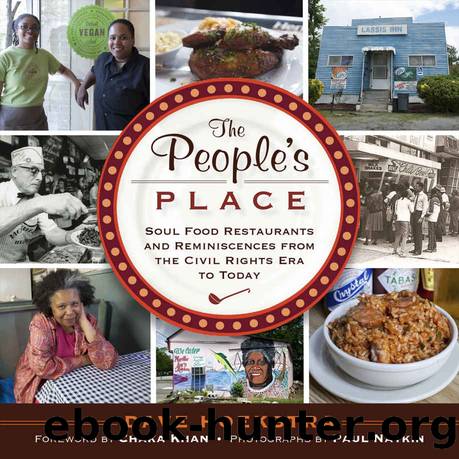The People's Place: Soul Food Restaurants and Reminiscences from the Civil Rights Era to Today by Dave Hoekstra

Author:Dave Hoekstra [Hoekstra, Dave]
Language: eng
Format: azw3
Publisher: Chicago Review Press
Published: 2015-09-30T16:00:00+00:00
Little Rock Central High School, built in 1927 and the site of forced desegregation in 1957.
“I cannot answer the question why that is.”
However, an ambitious visitor center was erected in 2007 across from Central High for the fiftieth anniversary commemoration of the event. In 1999 President Clinton presented the nation’s highest civilian award, the Congressional Medal of Honor, to the members of the Little Rock Nine.
The high school is still functioning, and with twenty-five hundred students is one of the top academically ranked schools in the country. The school is a National Historic Site operated by the National Park Service (US Department of the Interior). Voices of the Little Rock Nine interpret events on listening stations and a gift shop includes books, DVDs, and even Central High School T-shirts and hoodies. The Magnolia (Mobile) gas station across the street from the high school is part of the historic site because news reporters gathered there to use the pay phone. National Park Service spokesperson Jodi Morris said the center attracts about one hundred thousand visitors a year from all over the world.
Phyllis Brown lives just a few blocks away from Central High. Over lunch she wore a declarative dress and gold earrings. She found ways to smile as she mined her jagged memories, presenting the poise of an urban jazz singer—or a television personality. Brown never married. Her only son died in 2012.
Her father, Willie “Bob” Brown, was a self-employed mason. “It was heart touching that we would drive through white neighborhoods—and still now—and say, ‘I bet our father built that brick wall,’” she said. “Or, ‘I bet our father built that driveway.’” Their mother, Imogene Dix Brown, was the first African American nurse supervisor at Arkansas Children’s Hospital in Little Rock.
Imogene was from Morrilton in west Arkansas, about fifty miles from Little Rock, and this is important. “Blacks relocated to Arkansas in that area,” Phyllis recalled. “The land was lush and green. The soil was black and fertile. In order for us to have a normal childhood my mother took us to Morrilton to the house she was born in. My father had a 1955 green Pontiac with the sun visor in front. The moment we drove into the driveway we jumped out of the car. The home [then occupied by her mother’s brother] was a beautiful white house with a massive yard that had grape vines and walnut trees. My mother made grape jelly from those grapes. Gosh, it was so beautiful. There was a ‘Back to Africa’ movement that took place in that area. My father was from Rixen, about fifteen minutes away. He was born in 1900 so he saw slavery.”
Minnijean added, “I now live on a small acreage and do CSA [community supported agriculture] in northern Ontario. The influence for that is from Morrilton. They had peach trees. Walnut trees. A cow. Apparently I ate butter. I got influenced by my father’s sisters, who made blackberry pies and peach cobblers. I’m almost seventy-three and I’m re-creating that in my life.
Download
This site does not store any files on its server. We only index and link to content provided by other sites. Please contact the content providers to delete copyright contents if any and email us, we'll remove relevant links or contents immediately.
| African-American Studies | Asian American Studies |
| Disabled | Ethnic Studies |
| Hispanic American Studies | LGBT |
| Minority Studies | Native American Studies |
Cecilia; Or, Memoirs of an Heiress — Volume 1 by Fanny Burney(31333)
Cecilia; Or, Memoirs of an Heiress — Volume 3 by Fanny Burney(30934)
Cecilia; Or, Memoirs of an Heiress — Volume 2 by Fanny Burney(30889)
The Great Music City by Andrea Baker(21313)
We're Going to Need More Wine by Gabrielle Union(18073)
Bombshells: Glamour Girls of a Lifetime by Sullivan Steve(13108)
Pimp by Iceberg Slim(12931)
All the Missing Girls by Megan Miranda(12749)
Fifty Shades Freed by E L James(12451)
Norse Mythology by Gaiman Neil(11883)
Talking to Strangers by Malcolm Gladwell(11879)
Crazy Rich Asians by Kevin Kwan(8349)
Mindhunter: Inside the FBI's Elite Serial Crime Unit by John E. Douglas & Mark Olshaker(7834)
The Lost Art of Listening by Michael P. Nichols(6474)
Enlightenment Now: The Case for Reason, Science, Humanism, and Progress by Steven Pinker(6405)
Bad Blood by John Carreyrou(5769)
The Four Agreements by Don Miguel Ruiz(5511)
Weapons of Math Destruction by Cathy O'Neil(5037)
We Need to Talk by Celeste Headlee(4869)
